Safety summary
What happened
At about 1055 on 21 August 2014, train 3DA2, carrying containerised freight (including dangerous goods), arrived at Snowtown, South Australia. While at Snowtown, the crew noticed smoke coming from one of the containers conveying dangerous goods. The crew contacted ARTC Network Control to arrange for the Country Fire Service to attend the site. An exclusion zone was set up around the site and the fire was brought under control with minimal damage sustained.
What the ATSB found
The ATSB found that freight within the affected container, including undeclared dangerous goods, had been packed in a manner that was not in accordance with the code of practice for Transport of Dangerous Goods by Road or Rail, or the Genesee & Wyoming Australia dangerous goods policy.
- Genesee & Wyoming Australia had a documented policy on the transportation of dangerous goods, including a Standard Condition of Carriage, which documented the obligations of GWA’s customers when providing freight for transportation. However, GWA had no active verification processes in place to check and confirm compliance with those requirements (either in total or in part through random selection). Such a process may have provided the opportunity to detect any undeclared dangerous goods or inappropriately packed freight before an incident or accident resulted.
What's been done as a result
GWA has undertaken an independent audit of their policies and procedures for consigning freight, including the adequacy of training in receiving handling and storage of dangerous goods. GWA has also undertaken to improve communications with customers at their Alice Springs and Darwin terminals to identify where deficiencies may exist and how they might be best addressed.
Safety message
This incident illustrates the importance of freight forwarders and rail operators ensuring that dangerous goods freight accepted for carriage meets the relevant requirements of the Transport of Dangerous Goods by Road or Rail code of practice. All rail operators should ensure that their policies and procedures for the acceptance of dangerous goods are effective in ensuring that the goods accepted have been appropriately packed to minimise the risk of incidents during transportation.
Fire damage to goods
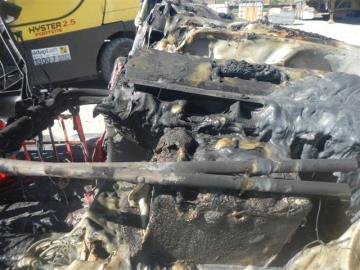
The occurrence
At about 09201 on 19 August 2014, train 3DA2, operated by Genesee & Wyoming Australia (GWA), departed from the Berrimah freight terminal (near Darwin, Northern Territory) bound for Islington Freight Terminal, South Australia. The train was scheduled to pick up and drop off freight at various locations during the journey.
At about 1015 on 20 August, the train arrived at the Alice Springs freight terminal where two freight wagons were dropped off and two picked up; one of which (FQAY0017H) was carrying dangerous goods. The two added wagons were marshalled into the second and third position behind the trailing crew van. Train 3DA2 departed the Alice Springs freight terminal at about 1105 and continued on towards Islington Freight Terminal with a train crew change scheduled at Snowtown, SA.
Figure 1: Location of Snowtown SA
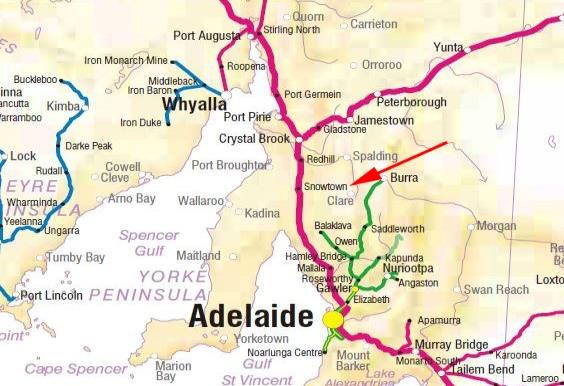
Source: Geoscience Australia annotated by the ATSB
At about 1055 on 21 August, train 3DA2 arrived at Snowtown, South Australia (Figure 1). The relief crew boarded 3DA2 and was preparing the train for departure when the driver noticed smoke coming from a container being conveyed on the centre platform of wagon FQAY 0017H. He checked the hazardous goods manifest and ascertained that the wagon contained hydrochloric acid solution. He then advised the Australian Rail Track Corporation (ARTC) Network Control Officer (NCO) that there was a fire in a wagon which had dangerous goods and to call the Country Fire Service (CFS) immediately. The crew then set up a 250 m exclusion zone and secured the train as part of their emergency procedure.
The NCO contacted the CFS at 1100 and also advised GWA Transport Control. The CFS arrived at 1130 and took control of the site. At about 1150 the train crew were removed from the train by the CFS. By 1310, the fire had been extinguished. There was some damage to goods in the direct vicinity of the fire but there was no damage to the wagon or rail infrastructure.
Through consultation with the CFS coordinator, the NCO authorised other train movements to pass the incident site via the loop track at about 1320 and 1508. The site was declared safe with no hazard for the public or the environment at about 1605.
The wagon was inspected by a GWA safety representative and deemed to be safe to continue its travel to Islington Freight Terminal. Train 3DA2 departed Snowtown at about 1624, arriving at Islington at about 1818 later that day.
Context
Train and crew information
Train 3DA2 was a GWA super freighter, consisting of two locomotives (GWU007 leading and CLP14 trailing) hauling 28 wagons of containerised freight, some of which included dangerous goods. It had a length of 1166 m and a trailing mass of 1821 t.
Train crew
The train crew possessed relevant competencies to operate the train and to transport dangerous goods. They were also trained in emergency management procedures.
Freight loading unloading at Alice Springs
The wagons attached to train 3DA2 at Alice Springs were loaded with containers packed by Toll Australia and delivered to the GWA freight terminal for transport to Islington Freight Terminal.
Container number 4CB215, loaded on wagon FQAY0017H, had been packed by Toll Australia with consignments from multiple customers, each with a consignment note signed by the customer. The consignment listed on the train’s manifest as dangerous goods consisted of hydrochloric acid solution, noted as 4 x 1000 l Intermediate Bulk Containers (IBC). The remaining consignments were general freight, though one also included an unsecured lead-acid battery2 which was not accompanied by a dangerous goods declaration.
The containers were received by GWA at their Alice Springs yard but were not inspected.
Fire on 3DA2 at Snowtown
GWA policy for train crew dealing with a fire event
GWA’s response plan for “on-rail’ emergencies involving a fire or dangerous goods event, required the train driver to take control of the site until they were relieved by a GWA Incident Response Coordinator or Incident Controller. To ensure train safety and integrity in accordance with the safe working regulations, the driver was required to remain at the controls in the lead locomotive. The response plan also required people to be evacuated if there were fire, smoke, vapour clouds or fumes and move to a safe distance uphill/up wind if there were dangerous goods involved. Transport (train) control was to be notified and required to constantly monitor the communications (radio) onsite.
In this case, once the relief crew noticed the smoke from the container, they obtained the train’s manifest to determine the nature of the freight inside. They identified that the smoke was coming from wagon FQAY0017H (container 4CB215), checked the hazardous goods manifest and determined the container contained hydrochloric acid solution. The driver immediately called the Network Control Officer (NCO), advised of the smoke coming from a container of dangerous goods and requested the fire brigade attend. The driver then set up a 250 m exclusion zone and remained with the train.
The NCO contacted the Country Fire Service (CFS) advised them of the fire and the quantity of hydrochloric acid solution that the manifest indicated was within the container.
The CFS contacted the customer of the hydrochloric acid solution and established that the quantity listed on the manifest differed to the actual amount being transported on board train 3DA2 – the containers being empty, with only residual acid product within.
The CFS further assessed the situation and determined that there was nothing leaking from the container. The decision by the CFS to physically access the container was deferred until the arrival of specialist equipment. The CFS permitted the NCO to operate other services past 3DA2 via the crossing loop track while waiting for the equipment. Once the equipment had arrived, the CFS requested that the NCO close the track again as they prepared to enter the container.
After an internal inspection of the container, the CFS determined that there were no further threats to personal safety or to the environment and allowed the track to be re-opened.
An inspection of the rolling stock was conducted by GWA to ensure the integrity of the train. Once it was determined that the risk of fire and contamination had been mitigated, and that the wagon was safe to continue, train 3DA2 departed Snowtown at 1624.
Emergency response to the dangerous goods fire
Network Control made the call to the emergency services and gave details about the type of dangerous goods and the amount involved. The initial assessment by the CFS was to approach the container fire with the expectation that there were substantial quantities of hydrochloric acid solution present.
The initial limited information available to the CFS on site hindered them in determining the possible ignition sources or the exact contents of the container. This compromised their most efficient response to the situation, including determining the extent of exclusion area or whether it was appropriate to commence a full evacuation. As such, the initial (default) response was to plan for the worst case and then to scale back the effort once more was known about the dangerous goods.
Throughout the incident, the NCO continued to coordinate with the emergency services, GWA and the train crew at the scene. The train crew and local staff managed the site according to their policy and procedures for on-rail emergencies.
The implementation of the GWA “on-rail emergency” plan and the coordination with ARTC effectively managed the incident and provided assistance and information to the emergency services as required.
Fire origin
Inspection of the container found a number of plastic tubs, one of which contained a lead-acid battery. At some point during the journey, an unsecured metal-framed portable chair had fallen across the exposed terminals of the battery (Figure 2).
The metal of the chair frame had shorted out the battery causing high current to flow and heat the metal frame. The heat transmitted from the chair frame resulted in the melting and combustion of the plastic tubs (Figure 3). The smoke produced by the burning plastic was subsequently observed coming from the container by the GWA train crew.
Figure 2: Tub with battery and metal frame of the chair.
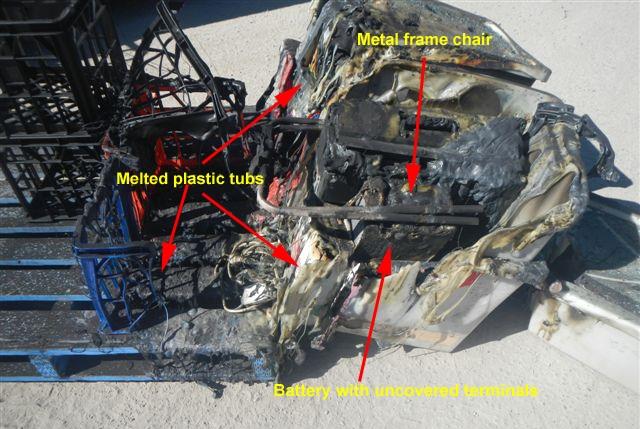
Source: Genesee & Wyoming Australia annotated by the ATSB.
Figure 3: Damaged freight in situ in the container
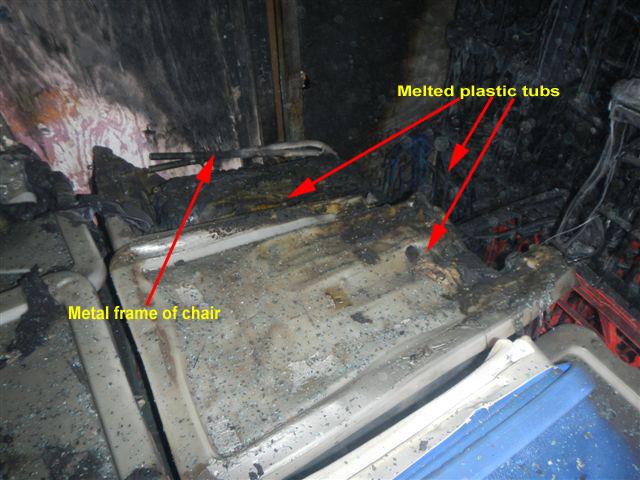
Source: Genesee & Wyoming Australia annotated by the ATSB
Dangerous goods
Transportation of dangerous goods at the time of this incident was governed by the Australian Dangerous Goods (ADG) Code 7.3 edition. The ADG Code is subject to regular reviews that keep pace with international developments and local industry best practice. The current edition is based on the recommendations of the Dangerous Goods Model Regulations 17th edition, United Nations, 2011.
The Code must be read in conjunction with the Model Act on the Transport of Dangerous Goods by Road or Rail3.The model act sets out, in general terms, the legal requirements for transporting dangerous goods by road and rail in Australia. It establishes the broad regulatory framework for the transport of dangerous goods and is complemented by the Model Subordinate Law.
Dangerous goods on train 3DA2
The train consist included wagon FQAY 00017H; a 5-pack4 48-foot artic skeletal wagon designed to carry containers, with an overall length of 79.1m. (Figure 4)
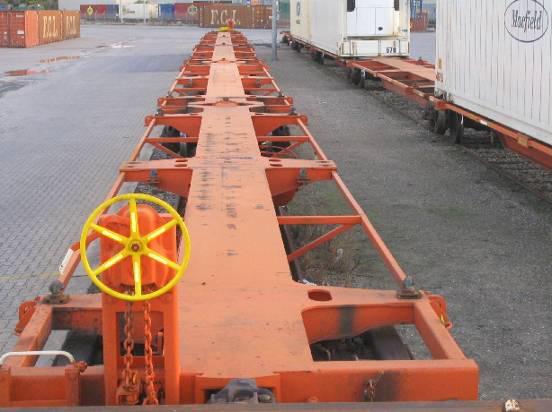
Source: Genesee & Wyoming Australia
The train manifest showed the wagon was located 6th in the sequence and was loaded with seven containers, including container number 4CB215, which contained dangerous goods and was the subject of the fire.
The container manifest for 4CB215 showed that it was loaded with 19 different consignments under individual consignment notes. There were three consignments listed in the category of dangerous goods, although these were not listed in the first part of the documentation as required by the ADG Code. The goods were listed as hazardous class 2.1 (gas sample) and hazardous class 8 (empty intermediate bulk containers of hydrochloric acid).
Genesee & Wyoming requirements for transporting dangerous goods
Genesee & Wyoming requirements for the transportation of dangerous goods are set out in their Domestic Intermodal Infopak. Within the Domestic Intermodal Infopak, Pacific National’s Freight Loading Manual (FLM) indicates how the freight should be handled during its transport.
Pacific National requirements for transporting dangerous goods
Pacific National sets out in its Freight Loading Manual, requirements for freight forwarders when consigning dangerous goods. Section FLM-01-_05 Transit of Dangerous Goods by Rail details the stowage of dangerous goods and also goods that are transported along with dangerous goods.
Safety analysis
Receiving of dangerous goods for transport by rail
The Dangerous Goods Code required that customers declare dangerous goods, and that those goods were adequately described, packaged and secured. The code further provided that batteries were classified as dangerous goods within the meaning of the code (and thus needed to be declared), if they were not secured within equipment. If they were carried with other goods, then all the goods were to be adequately secured to prevent movement or damage, or in the case of batteries, to prevent the terminals bridging and shorting.
Transporting dangerous goods by Genesee & Wyoming Australia
Genesee & Wyoming Australia policy on the transportation of dangerous goods is set out in their Intermodal Domestic Infopak document, which referred to Pacific Nationals Freight Loading Manual (FLM) for transporting freight.
Pacific National’s requirement for dangerous goods states that:
The FLM provides for the inspection of goods and freight before the freight is accepted – in particular if there is any ambiguity to the type of freight to be conveyed. There is also a function within the FLM to undertake random auditing of the freight to ensure compliance with the relevant stowage and declaration requirements.
While not referred to in GWA’s documentation, Pacific National’s Load Inspection Authority also states that random audits can be conducted while freight is still attached to the prime mover at the terminal gate or yard. Their standard condition of carriage also states that the customer authorises Pacific National to:
GWA’s equivalent document, Standard Condition of Carriage, makes no provision for inspection of freight that may contain undeclared dangerous goods. However, there is a requirement that:
and that:
While the intent was that any goods provided to GWA by customers shall be in a condition that is lawful, and while the provisions for inspection were present in the various associated documents, there was no procedure in place for the actual verification of compliance (either in total or in part through random selection). If such a procedure had been in place, it may have provided an opportunity to discover any undeclared dangerous goods (such as the exposed battery) and any loosely and inappropriately packed freight.
Findings
From the evidence available, the following findings are made with respect to the fire on the fourth wagon of train 3DA2 that occurred near Snowtown, SA, on 21 August 2014. These findings should not be read as apportioning blame or liability to any particular organisation or individual.
Safety issues, or system problems, are highlighted in bold to emphasise their importance. A safety issue is an event or condition that increases safety risk and (a) can reasonably be regarded as having the potential to adversely affect the safety of future operations, and (b) is a characteristic of an organisation or a system, rather than a characteristic of a specific individual, or characteristic of an operating environment at a specific point in time.
Contributing factors
- When consigned for transport, freight container 4CB215 contained an undeclared lead-acid battery packed alongside other freight that had not been secured in accordance with the operator’s requirements or those of the Australian National Code of Transport of Dangerous Goods by Road and Rail.
- During transport, it was likely that an unsecured metal-framed chair shorted the battery terminals, with the resulting heat melting and igniting the plastic tubs surrounding the battery.
Other factors that increased risk
- Genesee & Wyoming Australia had no procedure in place to verify (either in total or by random selection) that the nature or condition of freight provided by their customers, complied with their Standard Condition of Carriage. [Safety issue]
Other findings
- The procedures followed by Genesee & Wyoming Australia and ARTC Network Control, in their management of the fire emergency, were effective and followed their documented response protocols.
Safety issues and actions
The safety issues identified during this investigation are listed in the Findings and Safety issues and actions sections of this report. The Australian Transport Safety Bureau (ATSB) expects that all safety issues identified by the investigation should be addressed by the relevant organisation(s). In addressing those issues, the ATSB prefers to encourage relevant organisation(s) to proactively initiate safety action, rather than to issue formal safety recommendations or safety advisory notices.
All of the directly involved parties were provided with a draft report and invited to provide submissions. As part of that process, each organisation was asked to communicate what safety actions, if any, they had carried out or were planning to carry out in relation to each safety issue relevant to their organisation.
Genesee & Wyoming Australia procedures for acceptance of dangerous freight
Genesee & Wyoming Australia had no procedure in place to verify (either in total or by random selection) that the nature or condition of freight provided by their customers, complied with their Standard Condition of Carriage.
ATSB Safety issue: RO-2014-015-SI-01
Safety issue description:
Genesee & Wyoming Australia had no procedure in place to verify (either in total or by random selection) that the nature or condition of freight provided by their customers, complied with their Standard Condition of Carriage.
Proactive safety action taken by Genesee & Wyoming Australia
Action number: RO-2014-015-NSA-006
As a result of this occurrence, Genesee & Wyoming Australia advised that they have undertaken an independent audit of their policies and procedures for the receiving, storage, handling, transporting and delivery practices at the Alice Springs and Darwin yards – relative to dangerous goods on GWA-accredited intermodal trains. The audit encompassed the following aspects;
- Communications with customers re DGs at the time bookings are made – chain of responsibility.
- Receipt of DGs at terminal and adequacy of the receipting process. Documentation relative to GWA’s responsibilities and gaining assurance as to nature of the goods – chain of responsibility.
- Segregation and placarding of loaded and compliance of same with code of practice.
- Adequacy of training delivered to train crews, transport controllers and supervisors.
- Existence and adequacy of emergency/evacuation plans relative to DGs at the terminal.
ATSB comment in response
While the likelihood of such events is relatively low, Genesee Wyoming Australia’s review of policy and procedures will help identify opportunities to further mitigate the risks of transporting dangerous goods. The ATSB is satisfied that, when fully implemented, the actions proposed by Genesee & Wyoming Australia should address this safety issue.
Current status of the safety issue:
Issue status: Safety action pending
Justification: At the time of this report release, the safety action advised by Genesee & Wyoming Australia had not yet been fully implemented.
Sources and submissions
Sources of information
The sources of information during the investigation included:
- Genesee & Wyoming Australia
- Australian Rail Track Corporation
- Pacific National
- Toll Ipec
References
Australian code for the Transport of Dangerous Goods by Road & Rail Edition 7.3, August 2014
Pacific National Freight Loading Manual FLM 00-97 Transit of dangerous goods by rail FLM 01-06_05.
Pacific National Freight Loading Manual FLM 00-97 Provisional load process FLM 01-12
Pacific National Freight Loading Manual FLM 00-97 Acceptance of loading FLM 01-02
Pacific National Freight Loading Manual FLM 00-97
Genesee & Wyoming Australia Domestic Intermodal Infopak, October 2013
Genesee & Wyoming Standard Condition of Carriage Rev A
Genesee & Wyoming Australia Provisional Load Procedure GWA-FLP-03-006_01
Genesee & Wyoming Australia Response plan for “on rail” emergencies RS-PRC-006 version 008
Submissions
Under Part 4, Division 2 (Investigation Reports), Section 26 of the Transport Safety Investigation Act 2003 (the Act), the Australian Transport Safety Bureau (ATSB) may provide a draft report, on a confidential basis, to any person whom the ATSB considers appropriate. Section 26 (1) (a) of the Act allows a person receiving a draft report to make submissions to the ATSB about the draft report.
A draft of this report was provided to Genesee & Wyoming Australia, The Office of National Rail Safety Regulator (ONRSR), Toll Ipec, the Australian Rail Track Corporation, Pacific National and the train crew of 3DA2.
Responses and/or submissions were received from Genesee & Wyoming Australia, The Office of National Rail Safety Regulator (ONRSR), Toll Ipec, the Australian Rail Track Corporation, Pacific National and the train crew of 3DA2. The submissions were reviewed and where considered appropriate, the text of the report was amended accordingly.
Purpose of safety investigationsThe objective of a safety investigation is to enhance transport safety. This is done through:
It is not a function of the ATSB to apportion blame or provide a means for determining liability. At the same time, an investigation report must include factual material of sufficient weight to support the analysis and findings. At all times the ATSB endeavours to balance the use of material that could imply adverse comment with the need to properly explain what happened, and why, in a fair and unbiased manner. The ATSB does not investigate for the purpose of taking administrative, regulatory or criminal action. TerminologyAn explanation of terminology used in ATSB investigation reports is available here. This includes terms such as occurrence, contributing factor, other factor that increased risk, and safety issue. Publishing informationReleased in accordance with section 25 of the Transport Safety Investigation Act 2003 Published by: Australian Transport Safety Bureau © Commonwealth of Australia 2015
Ownership of intellectual property rights in this publication Unless otherwise noted, copyright (and any other intellectual property rights, if any) in this report publication is owned by the Commonwealth of Australia. Creative Commons licence With the exception of the Coat of Arms, ATSB logo, and photos and graphics in which a third party holds copyright, this publication is licensed under a Creative Commons Attribution 3.0 Australia licence. Creative Commons Attribution 3.0 Australia Licence is a standard form licence agreement that allows you to copy, distribute, transmit and adapt this publication provided that you attribute the work. The ATSB’s preference is that you attribute this publication (and any material sourced from it) using the following wording: Source: Australian Transport Safety Bureau Copyright in material obtained from other agencies, private individuals or organisations, belongs to those agencies, individuals or organisations. Where you wish to use their material, you will need to contact them directly. |
_____________________
1. The 24 hour clock is used in this report to describe the local time of day, Central Standard Time (CST)
2. The Dangerous Goods Code provides that cells and batteries, except when installed in equipment, must be packed in inner packaging that completely enclose the cell or battery or must be protected so as to prevent short circuits.
3. Source: Australian Code for the Transport of Dangerous Goods by Road and Rail available at www.ntc.gov.au
4. An articulated wagon comprising five platforms, the adjacent ends of individual units being supported on a common bogie and permanently connected by a device which permits free rotation in all planes. RISSB, Glossary of Railway Terminology - Guideline


